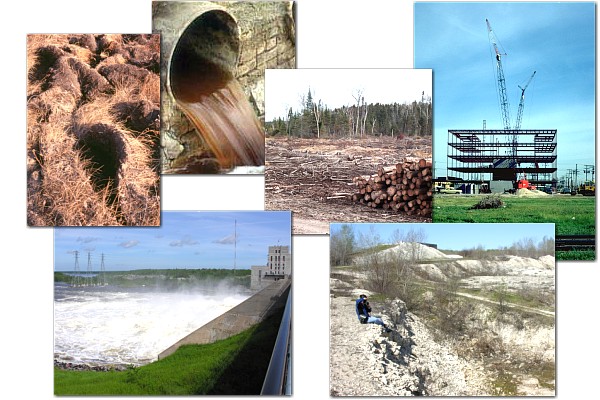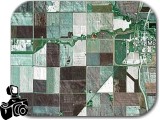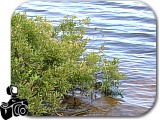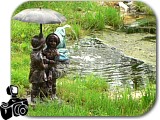| |
| 
We may claim to like them, but we humans
are dragonflies’ worst enemies. While creating our
own habitat we have destroyed much of their natural habitat.
All our activities: farming, mining, logging, and building
roads and cities, affect dragonflies and all Manitoba’s
wildlife. Actions that affect wetlands have the greatest
impact on dragonflies, whether it is building Hydro-electric
dams, wetland drainage or pollution from agricultural runoff
and city sewage.

 In
Manitoba’s Prairies Ecozone, very little of the original
grassland habitat remains, and most of the wetlands (marshes,
ponds and potholes) have been drained to improve agriculture. In
Manitoba’s Prairies Ecozone, very little of the original
grassland habitat remains, and most of the wetlands (marshes,
ponds and potholes) have been drained to improve agriculture.
 Currently,
no dragonflies in Manitoba are considered to be Species
at Risk, but this is mainly because we know so little about
their populations. Currently,
no dragonflies in Manitoba are considered to be Species
at Risk, but this is mainly because we know so little about
their populations.
|
| 
 Dragonflies
have been around for over 250 million years. They are good
indicator species for the health of our aquatic environments.
To conserve Manitoba’s dragonflies for future generations
we must protect their habitat now. That means protecting
all kinds of wetlands and uplands in all our ecozones; preserving
both the quantity and quality of lakes, rivers, ponds and
marshes and their surrounding habitats throughout our province.
Healthy, clean and diverse wetland ecosystems will always
have lots of dragonflies. Dragonflies
have been around for over 250 million years. They are good
indicator species for the health of our aquatic environments.
To conserve Manitoba’s dragonflies for future generations
we must protect their habitat now. That means protecting
all kinds of wetlands and uplands in all our ecozones; preserving
both the quantity and quality of lakes, rivers, ponds and
marshes and their surrounding habitats throughout our province.
Healthy, clean and diverse wetland ecosystems will always
have lots of dragonflies.

What can you do to help Manitoba’s
dragonflies? Here are some ideas:
- Make a donation to an agency that
promotes conservation of natural habitat in Manitoba,
or that promotes environmental education.
- Go Green! Minimize use of pesticides
and fertilizers. Use less water and energy. Walk or bike
instead of driving. Avoid buying products you can’t
reuse or recycle. When you reduce your impact on our environment,
you help all wildlife.
- Express yourself! Let your friends,
neighbours, local politicians and others know that you
care about dragonflies and want them and their habitat
protected. Make your ideas and your vote count!
-
 Build
a backyard dragonfly pond. Nearly any significant
body of water can be habitat for dragonflies. A “dragonfly
pond” should be at least 30 cm deep and have a variety
of plants in the water and around the pond edge. There
should be rocks, pebbles and sticks in the water to create
a diverse habitat with hiding places for nymphs. Small
fish, like guppies or sticklebacks, in the water are a
good idea to help control mosquito larvae, and to be food
for larger nymphs, but larger fish, like goldfish and
koi, will eat too many nymphs. A small pond will freeze
to the bottom in winter, so it will be habitat only for
species that complete the nymph stage in one summer. A
larger pond that doesn’t freeze solid, at least
1 m deep, can be habitat for many more species. Build
a backyard dragonfly pond. Nearly any significant
body of water can be habitat for dragonflies. A “dragonfly
pond” should be at least 30 cm deep and have a variety
of plants in the water and around the pond edge. There
should be rocks, pebbles and sticks in the water to create
a diverse habitat with hiding places for nymphs. Small
fish, like guppies or sticklebacks, in the water are a
good idea to help control mosquito larvae, and to be food
for larger nymphs, but larger fish, like goldfish and
koi, will eat too many nymphs. A small pond will freeze
to the bottom in winter, so it will be habitat only for
species that complete the nymph stage in one summer. A
larger pond that doesn’t freeze solid, at least
1 m deep, can be habitat for many more species.
- Join the Manitoba Dragonfly Survey.
The MDS, with its many volunteers, is playing
 an
important role providing basic information on dragonflies
to Manitoba Conservation and other agencies. Knowledge
is power, and a greater knowledge of Manitoba’s
dragonflies will provide more power to protect them. For
more on the MDS, or if you’d like to join, visit: an
important role providing basic information on dragonflies
to Manitoba Conservation and other agencies. Knowledge
is power, and a greater knowledge of Manitoba’s
dragonflies will provide more power to protect them. For
more on the MDS, or if you’d like to join, visit:
The Manitoba
Dragonfly Survey website |
|  The
fate of Manitoba's dragonflies and of all our wildlife
is in YOUR hands! The
fate of Manitoba's dragonflies and of all our wildlife
is in YOUR hands!
|
|
|

Fly back to NatureNorth.com |
|
| |
|